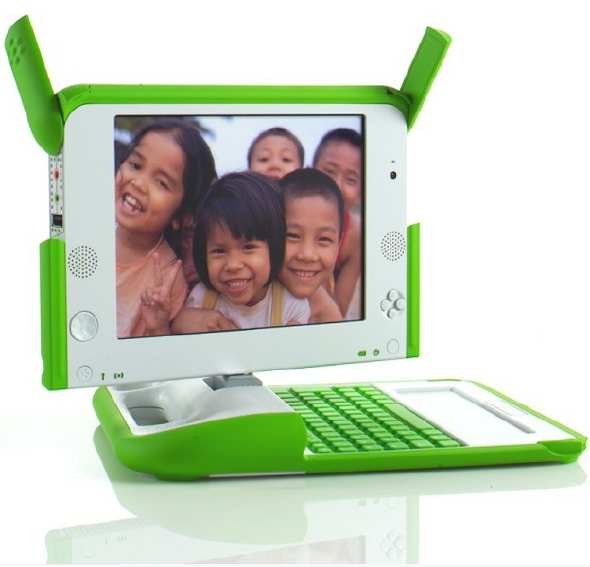Most criticism of the One Laptop Per Child PC centers on the cost for what is a low-spec computer. As ASUS with its Eee machine is proving, a low-cost conventional laptop can be pretty powerful. But that misses the point. The OLPC is a fundamental rethinking of the computing experience.
 [photo courtesy OLPC]
[photo courtesy OLPC]
This child’s review of the OLPC is the first hint that suggests that Laptop.org may have gotten it right. As the 9 year old’s father writes:
So Rufus is using his laptop to write, paint, make music, explore the internet, and talk to children from other countries.
Because it looks rather like a simple plastic toy, I had thought it might suffer the same fate as the radio-controlled dinosaur or the roller-skates he got last Christmas – enjoyed for a day or two, then ignored.
Instead, it seems to provide enduring fascination.
I had returned from Nigeria not entirely convinced that the XO laptop was quite as wonderful an educational tool as its creators claimed. I felt that a lot of effort would be needed by hard-pressed teachers before it became more than just a distracting toy for the children to mess around with in class.
But Rufus has changed my mind.
With no help from his Dad, he has learned far more about computers than he knew a couple of weeks ago, and the XO appears to be a more creative tool than the games consoles which occupy rather too much of his time.
OLPC roots
Even though the OLPC is the only notebook whose industrial design chops rival those of Apple, its real innovation lies in software. Building on educational theorist Seymour Papert’s work – he invented the Logo language – the OLPC’s re-thinks the relationship between man and machine.
OLPC differences
The OLPC has activities instead of applications.
Activities are distinct from applications in their foci—collaboration and expression—and their implementation—journaling and iteration.
The collaboration comes in the form of built-in mesh networking that allows all local OLPCs to talk to each other.
By exploiting this connectivity, every activity has the potential to be a networked activity. We aspire that all activities take advantage of the mesh; any activity that is not mesh-aware should perhaps be rethought in light of connectivity. As an example, consider the web-browsing activity bundled with the laptop distribution. Normally one browses in isolation, perhaps on occasion sending a friend a favorite link. On the laptop, however, a link-sharing feature integrated into the browser activity transforms the solitary act of web-surfing into a group collaboration.
The connectivity seems to be powerful. Young Rufus is conversing with other kids who send him messages in Spanish from his home in England. How does that work?
Expression is the goal of the activities and collaboration. Rather than downloading music, the laptop is equipped to create music. The rethinking extends to the file system:
The objectification of the traditional file system speaks more directly to real-world metaphors: instead of a sound file, we have an actual sound; instead of a text file, a story. In order to support this concept, activity developers may define object types and associated icons to represent them.
Another aspect of the system’s UI is a focus on the Journal. This is more than written documentation of what a child has done.
The Journal combines entries explicitly created by the children with those that are implicitly created through participation in activities; developers must think carefully about how an activity integrates with the Journal more so than with a traditional file system that functions independently of an application. The activities, the objects, and the means of recording all tightly integrate to create a different kind of computer experience.
I’ll be interested to see how children who grow up with the OLPC think about computers. I fear we have a generation of children whose creativity has been permanently stunted by the desktop metaphor.
The StorageMojo take
Negroponte’s biggest mistake is that he did not market the OLPC in the industrialized world first. All the good intentions in the world won’t convince the 3rd world that something is good unless it has been embraced by the opinion leaders of the 1st world.
If I was Steve Jobs, I’d be taking a very close look at this machine to see what I could steal. Michael Dell could learn a few things too.
Comments welcome. OLPC has a beautiful web site.


What do you think about Mary Lou Jepsen
saying that is could be $75 dollars instead of $200?